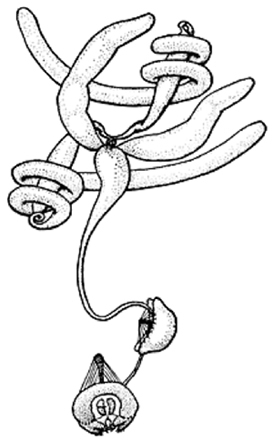Abstract
The testes of Drosophila melanogaster provide an important model for the study of stem cell maintenance and differentiation, meiosis, and soma-germline interactions. Testes are typically isolated from adult males 0-3 days after eclosion from the pupal case. The testes of wild-type flies are easily distinguished from other tissues because they are yellow, but the testes of white mutant flies, a common genetic background for laboratory experiments are similar in both shape and color to the fly gut. Performing dissection on a glass microscope slide with a black background makes identifying the testes considerably easier. Testes are removed from the flies using dissecting needles. Compared to protocols that use forceps for testes dissection, our method is far quicker, allowing a well-practiced individual to dissect testes from 200-300 wild-type flies per hour, yielding 400-600 testes. Testes from white flies or from mutants that reduce testes size are harder to dissect and typically yield 200-400 testes per hour.
Keywords: Cellular Biology, Issue 51, Microdissection, Drosophila melanogaster, testes, germline
Protocol
Make a glass microscope slide with a black background: Cut 20# white paper to the same size as the microscope slide. Color one side of the slide-size paper black using a permanent marker (e.g., Sharpie). Apply white glue (Elmer's) to the black side and adhere the paper to the slide. The slide can be reused. Using ¾" label tape (Fisherbrand), secure the microscope slide, glass side up, to the CO2 fly pad to fix it in place.
Collect 0-3 day old male flies.
Prepare a bucket of ice, phosphate-buffered saline (PBS), dissecting needles.
Anaesthetize 50-100 flies using a stream of CO2and transfer them from the bottle or vial to the fly pad near the microscope slide.
Pipette ~50 μl ice-cold PBS in a drop in the middle of the microscope slide.
Gently pick up a male fly with the dissecting needle—dip the dissecting needle into PBS, gentle touch the ventral side (i.e., near the wings) of the fly with the needle—place it into the drop of PBS.
Place one needle on the middle of the fly, between the thorax and the abdomen, pushing down firmly. Place the other needle between the sixth (A6) and seventh (A7) abdominal segments (the second and third stripes from the bottom); pull the abdomen away from the thorax.
Tease the testes apart from other organs, especially the gut. Especially in white mutants, testes and gut look similar. Key differences are that testes always come in pairs; each testis has a spiral pattern and is more white in color than gut.
Store the testes in ice-cold PBS in a polypropylene microcentrifuge tube.
Representative Results:
 Figure 1. Dorsal view of the male reproductive system,from flybase.org/reports/FBim0000074.html. Flybase attribution: "After Figure 38 A on page 508 from Miller (1950). A. Miller. The internal anatomy and histology of the imago of Drosophila melanogaster. In M. Demerec, editor, Biology of Drosophila, chapter 6, pages 420-534. Cold Spring Harbor Laboratory Press, facsimile edition, 1994. Copyright 1994 by Cold Spring Harbor Laboratory Press. Used with kind permission from Cold Spring Harbor Laboratory (CSHL) Press. See http://www.cshlpress.com."
Figure 1. Dorsal view of the male reproductive system,from flybase.org/reports/FBim0000074.html. Flybase attribution: "After Figure 38 A on page 508 from Miller (1950). A. Miller. The internal anatomy and histology of the imago of Drosophila melanogaster. In M. Demerec, editor, Biology of Drosophila, chapter 6, pages 420-534. Cold Spring Harbor Laboratory Press, facsimile edition, 1994. Copyright 1994 by Cold Spring Harbor Laboratory Press. Used with kind permission from Cold Spring Harbor Laboratory (CSHL) Press. See http://www.cshlpress.com."
Discussion
We provide a protocol to isolate testes from adult maleDrosophila melanogaster. Because the technique requires coordinating one's two hands, skill comes only with practice.
Disclosures
No conflicts of interest declared.
Acknowledgments
The authors thank Vasia Vagin for introducing this technique into our laboratory.
References
- Singh SR, Hou SX. Immunohistological Techniques for Studying the Drosophila Male Germline Stem Cell. Methods Mol Biol. 2008;450:45–59. doi: 10.1007/978-1-60327-214-8_3. [DOI] [PubMed] [Google Scholar]


